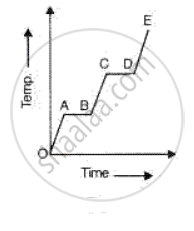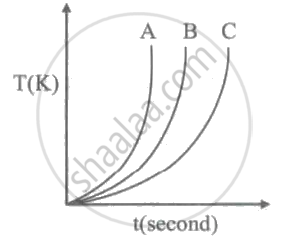Advertisements
Advertisements
Question
Indian style of cooling drinking water is to keep it in a pitcher having porous walls. Water comes to the outer surface very slowly and evaporates. Most of energy needed for evaporation is taken from the water itself and the water is cooled down. Assume that a pitcher contains 10 kg of water and 0.2 g of water comes out per second. Assuming no backward heat transfer from the atmosphere to the water, calculate the time in which the temperature decrease by 5°C. Specific heat capacity of water = 4200 J kg−1 °C−1 and latent heat of vaporization of water = 2.27 × 106 J kg−1.
Solution
Given:-
Specific heat of water ,S = 4200 J kg−1 °C−1
Latent heat of vapourisation of water ,L = 2.27 × 106 J kg−1
Mass, M = 0.2 g = 0.0002 kg
Let us first calculate the amount of energy required to decrease the temperature of 10 kg of water by 5°C.
U1 = 10 × 4200 J/kg°C × 5°C
U1 = 210,000 = 21 × 104 J
Let the time in which the temperature is decreased by 5°C be t.
Energy required per second for evaporation of water (at the rate of 0.2 g/sec) is given by
U2 = ML
U2 = (2 × 10−4 )× (2.27 × 106) = 454 J
Total energy required to decrease the temperature of the water = 454 × t
= 21 × 104 J
Now,
\[t= \frac{21 \times {10}^4}{454}\text{ seconds}\]
The time taken in minutes is given by
\[t= \frac{21 \times {10}^4}{454 \times 60} = 7 . 7\text{ minutes}\]
∴ The time required to decrease the temperature by 5°C is 7.7 minutes.
APPEARS IN
RELATED QUESTIONS
Calculate the mass of ice needed to cool 150 g of water contained in a calorimeter of mass 50 g at 32 °C such that the final temperature is 5 °C. Specific heat capacity of calorimeter = 0.4 J g-1 °C-1, Specific heat capacity of water = 4.2 J g-1°C-1, latent heat capacity of ice = 330 J g-1.
A copper vessel of mass 100 g contains 150 g of water at 50°C. How much ice is needed to cool it to 5°C?
Given: Specific heat capacity of copper = 0.4 Jg-1 °C-1
The Specific heat capacity of water = 4.2 Jg-1 °C-1
The Specific latent heat of fusion ice = 336 Jg-1
What property of water makes it an effective coolant?
Water in lakes and ponds do not freeze at once in cold countries. Give a reason is support of your answer.
50 g of metal piece at 27°C requires 2400 J of heat energy so as to attain a temperature of 327°C . Calculate the specific heat capacity of the metal.
Differentiate between heat capacity and specific heat capacity.
Write the approximate value of specific heat capacity of water in S.I. unit.
Why do the farmers fill their fields with water on a cold winter night?
Discuss the role of high specific heat capacity of water with reference to climate in coastal areas.
What impact will global warming have on the health of the affected population?
A calorimeter has mass 100 g and specific heat 0.1 kcal/ kg °C. It contains 250 gm of liquid at 30°C having specific heat of 0.4 kcal/kg °C. If we drop a piece of ice of mass 10 g at 0°C, What will be the temperature of the mixture?
A substance is heated at a constant rate from a low temperature to a high temperature. A graph of temperature against time is shown in the figure. Which part or parts of the graph correspond(s) to the substance existing in two states?

What change in heat energy occurs when lead at its melting point
solidifies without change in the temperature?
650 J of heat is required to raise the temp. of 0.25 kg of lead from 15°C to 35°C. Calculate the Sp. heat capacity of lead.
A liquid X has specific heat capacity higher than the liquid Y. Which liquid is useful as coolant in car radiators.
Does the specific heat capacity of a substance depend upon its mass and rise in temperature only?
Explain, why do sandy soils, get heated up quickly as compared to wet soils?
Explain, why water is considered as best liquid for quenching thirst?
1 kg of water freezes to form ice at 0°C. What amount of heat is withdrawn?
Describe a method to determine the specific heat capacity of a solid (say, a piece of copper).
A vessel of negligible heat*capacity contains 40g of ice in it at 0°C, 8g of steam at 100°C is passed into the ice to melt it. Find the final temperature of the contents of the vessel.
(Specific latent heat of vaporization of steam = 2268 J/g, specific latent heat of fusion of ice = 336 J/f and specific heat capacity of water = 4.2 J/g°C)
Solve the following problem.
What is the specific heat of metal if 50 cal of heat is needed to raise 6 kg of the metal from 20°C to 62 °C?
Write the name.
The amount of heat absorbed at constant temperature by unit mass of a liquid to convert into gaseous phase.
All metals have the same specific heat capacity.
Consider the statement given below and choose the correct option.
Assertion: Radiation is a form of heat transfer which takes place only in vacuum.
Reason: The thermal energy is transferred from one part of a substance to another part without the actual movement of the atoms or molecules.
If 'Cp' and 'Cv' are molar specific heats of an ideal gas at constant pressure and volume respectively. If 'λ' is the ratio of two specific heats and 'R' is universal gas constant then 'Cp' is equal to ______.
Which of the following substances (A, B and C) has the highest specific beat?

A monoatomic gas of pressure 'P' having volume 'V' expands isothermally to a volume '2V' and then adiabatically to a volume '16V'. The final pressure of the gas is ______.
(ratio of specific heats = `5/3`)
An office room contains about 4000 moles of air. The change in the internal energy of this much air when it is cooled from 34° C to 19° C at a constant pressure of 1.0 atm is (Use `gamma_"air"` = 1.4 and Universal gas constant = 8.314 J / mol K) ____________.
Two metals A and B have specific heat capacities in the ratio 2:3. If they are supplied same amount of heat then
Which metal piece will have greater mass if the rise in temperature is the same for both metals?
Two metals A and B have specific heat capacities in the ratio 2:3. If they are supplied same amount of heat then
If specific heat capacity of metal A is 0.26 Jg-1 0C-1 then calculate the specific heat capacity of metal B.
Conductors have generally high specific heat capacities and insulators have low specific heat capacities.
Match the following:
| Column A | Column B | ||
| 1. | Specific heat capacity of water | a. | 0°C |
| 2. | Latent heat of fusion of ice | b. | 2260 J/g |
| 3. | Latent heat of vaporization of water | c. | 100°C |
| 4. | The melting point of iced | d. | 4.2 J/g°C |
| 5. | The boiling point of water | e. | 336 J/g |
To study energy exchange between hot and cold objects, the system of both objects is isolated from the environment by keeping them inside ______.
Match the columns:
| Column ‘A’ | Column ‘B’ |
| The SI unit of specific heat capacity | (a) Jkg−1°C−1 |
| (b) kg/m3 | |
| (c) calorie |
The specific heat capacity of ______ is maximum.
Specific heat capacity of a substance X is 1900 Jkg-1°C-1 means ______.
